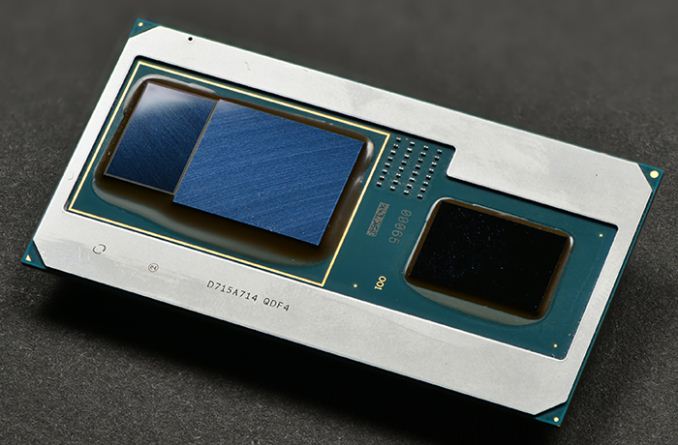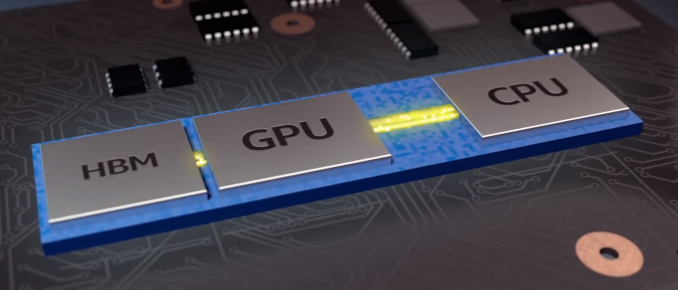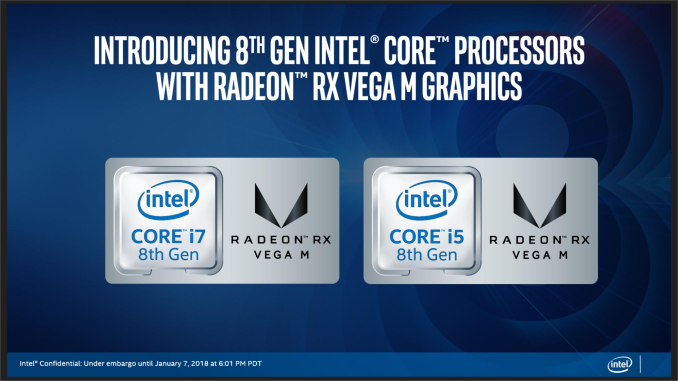Intel Core with Radeon RX Vega M Graphics Launched: HP, Dell, and Intel NUC
by Ian Cutress on January 7, 2018 9:02 PM EST
It’s here – one of the most unlikely partnerships in the semiconductor industry. Long-time rivals Intel and AMD, battling out of x86 dominance for over 35 years, are now co-conspirators. Take one part Intel’s high-performance 8th generation processor core, one part with AMD’s efficient Vega graphics, mix together with 4 GB of HBM memory and sprinkle in some high-performance interconnect.
The new products are officially labeled as ‘Intel 8th Generation Core with Radeon RX Vega M Graphics’, although this will be shortened to ‘Intel with Radeon Graphics’ for ease of use.
Intel with Radeon Graphics is strictly speaking a new Intel specific product, to be marketed and distributed as such. Today’s official launch builds on the platform announcement made late last year, with added additional specifications, confirmation of the feature set, and a series of new products based on Intel with Radeon Graphics are set to be announced this week at CES from Dell, HP, and Intel's own NUC. Aside from the NUC, we've been told to hold the other vendor information until their embargo times have arrived.
As we explained in our previous coverage, Intel with Radeon Graphics uses an ‘H-series’ Intel central processor and an AMD Radeon graphics processor as two distinct bits of silicon on the same package (a multi-chip package). Intel is buying the graphics processor from AMD, much like any other silicon purchase, and as a result, AMD’s involvement is strictly business. The graphics processor part is designed by AMD’s semi-custom division that deals with custom designs, such as the chips that go into Sony’s PlayStation 4 and Microsoft’s Xbox line. The graphics is connected to high-bandwidth memory, specifically the second generation HBM (known as HBM2), and the connection between the two uses Intel’s new embedded multi-die interconnect bridge technology, or EMIB for short. In other words, Intel CPU + AMD GPU + HBM2 + EMIB – acronyms are ablaze with these new chips.
The new products are an expansion of Intel’s traditional mobile product segmentation, which up until this point has been known as ‘YUH’. The new products fall under the ‘G’ name, designed to combine the high-performance of a H processor with the versatility of a U processor. The overall list of five/six segments, including the desktop and extreme segments, now looks as follows:
- Y – SoCs up to 4.5W, for portable fanless designs and 2-in-1s
- U – SoCs around 15W, for sleek high-performance lifestyle products
- H – CPUs around 35W/45W, offering more cores for larger enthusiast notebooks
- G – CPUs with additional graphics*, up to 100W
- S – Desktop processors
- X – A special segment for high-end desktops based on server processors
*May or may not have a separate graphics chip
The G-class Intel with Radeon Graphics processors being launched today are bigger than the standard processors that we would normally expect for mobile platforms, coming in with a TDP of 65W and 100W, although how power is managed between the two is part of Intel’s story with the new processors.
Without further ado, the specifications for the new parts are as follows:
| Intel's 8th Generation Core Processors with Radeon RX Vega M Graphics |
|||||
| Core i7-8809G |
Core i7-8709G |
Core i7-8706G |
Core i7-8705G |
Core i5-8305G |
|
| CPU uArch | Kaby Lake | Kaby Lake | |||
| On-Package Graphics (pGPU) |
Radeon RX Vega M GH | Radeon RX Vega M GL | |||
| CPU Cores | 4 / 8 | 4 / 8 | |||
| CPU Base Freq | 3.1 GHz | 3.1 GHz | 3.1 GHz | 3.1 GHz | 2.8 GHz |
| CPU Turbo Freq | 4.2 GHz | 4.1 GHz | 4.1 GHz | 4.1 GHz | 3.8 GHz |
| pGPU Compute Units | 24 CUs (1536 SPs) | 20 CUs (1280 SPs) | |||
| pGPU Frequency | 1063 MHz (1190 MHz Boost) |
931 MHz (1101 MHz Boost) |
|||
| pGPU Pixels/Clock | 64 | 32 | |||
| CPU PCIe Lanes | 8 to Radeon Graphics 8 for Other Use |
8 to Radeon Graphics 8 for Other Use |
|||
| Chipset + PCIe | 200-series derivative? 14-20 PCIe 3.0 Lanes |
200-series derivative? 14-20 PCIe 3.0 Lanes |
|||
| Package TDP | 100 W | 65 W | |||
| HBM2 Capacity | 4 GB | 4 GB | |||
| HBM2 Frequency | 800 MHz | 700 MHz | |||
| HBM2 Bit-Width | 1024-bit | 1024-bit | |||
| HBM2 Bandwidth | 204.8 GB/s | 179.2 GB/s | |||
| Quoted SP Perf | Up to 3.7 TFLOPS (SP) | Up to 2.6 TFLOPS (SP) | |||
| Intel HD Graphics | HD 630 | HD 630 | |||
| iGPU Frequency | Up to 1100 MHz | Up to 1100 MHz | |||
| DRAM | Dual Channel, DDR4-2400 | Dual Channel, DDR4-2400 | |||
| ECC | No | No | |||
| vPro | No | No | Yes | No | No |
| Overclocking | CPU, iGPU, pGPU, HBM | No | No | No | No |
*Added Core i7-8706G on 1/8
Each of the new parts is a quad-core design using HyperThreading, with Intel’s HD 630 GT2 graphics as the traditional ‘integrated’ low power graphics (iGPU) for video playback and QuickSync. This is connected via eight PCIe 3.0 lanes to the ‘package’ graphics (pGPU) chip, the Radeon RX Vega M, leaving 8 PCIe 3.0 lanes from the CPU to use for other functionality (GPU, FPGA, RAID controller, Thunderbolt 3, 10 Gigabit Ethernet).
On the Radeon RX Vega M graphics, there is one version of the silicon for which there will be two variants: the ‘GH’ will be the highest part (H for high) with 24 compute units (1536 streaming processors), 64 pixels per clock, running at a base frequency of 1063 MHz and can boost up to 1190 MHz. The second variant is the GL part (L for low), with 20 compute units (1280 streaming processors), 32 pixels per clock, running at a base frequency of 931 MHz and can boost up to 1011 MHz.
Both pGPU Radeon variants will have access to 4GB of HBM2 as an immediate graphics memory (this is not available to the CPU as DRAM). With one stack of HBM2, this means a 1024-bit bus width, which for the GH parts runs at 800 MHz for 208.6 GB/s bandwidth, or for the GL parts runs at 700 MHz for 179.6 GB/s bandwidth. Intel likes to stress that this bandwidth is only possible due to its EMIB technology, as currently all non-Intel HBM2 products available require an expensive bulky interposer that adds z-height: by using EMIB, Intel claims, the performance is on par with an interposer without the added bulk or most of the cost.
Only the Core i7-8809G, the highest placed processor, will offer overclocking. Intel has defined this chip as able to overclock the processor core, the integrated graphics frequency, the package graphics frequency, and the high bandwidth memory frequency (as well as system level DRAM). Overclocking will be dependent on how the vendor implements the feature set and software: nominally Intel is stating that in Windows 10, the CPU/iGPU can be overclocked through Intel XTU software, while the pGPU and HBM2 will need AMD’s Radeon Wattman software. It is not clear if/when an Intel-specific version of the latter will be distributed, given that when asked where the driver/software stack for the Radeon graphics should come from, we were told ‘all the software will come from Intel, consider this a fully-enabled Intel processor’.
We confirmed with Intel that all the processors support VT-x and VT-d, and that none of the processors support ECC. Only the i7-8706G is vPro enabled.












66 Comments
View All Comments
haukionkannel - Monday, January 8, 2018 - link
This. Vega is very effisient in low clock rates!Yojimbo - Sunday, January 7, 2018 - link
Where do they claim that it will beat the GTX 1050 in terms of power efficiency? They show some select benchmarks that imply a certain efficiency in those specific cases, but I didn't see that they mentioned general power efficiency or price at all.This package from Intel does have HBM, which is more power efficient than GDDR5. That will help. But overall, my expectation is that Intel's new chip will be less efficient in graphics intensive tasks than a system with a latest generation discrete NVIDIA GPU. The dynamic tuning should help in cases where both CPU and GPU need to draw significant power, though.
We probably know how Vega performs. Assuming that the chips aren't TDP constrained, the more powerful of the two variants should probably perform somewhere between a 560 and 570 in games. The lesser variant should perform around a 560, less or more depending on how memory bandwidth plays into things. We'll have to see how power constraints factor into to things though.
Another thing to keep in mind is that for most of its lifetime, this chip will probably be going up against NVIDIA's next generation of GPUs and not their current generation. Intel did benchmark it against a 950M, but I wouldn't put it past them to ignore price differences in a comparison they release. The new chips will probably be expensive enough that they will have to go up against the latest generation of their competitor's chips.
Kevin G - Monday, January 8, 2018 - link
This does leave room for Intel produce a slimmer GT1 or even omitting a GPU entirely for mobile when the know that it will be paired with a Radeon Vega on package. That'd permit Intel to decrease costs on their end, though this would up to Intel to pass onward to OEMs.nico_mach - Monday, January 8, 2018 - link
AMD wasn't good at efficiency mostly due to fabbing. That's easily fixable with a deep-pocketed and suddenly desperate partner like Intel.artk2219 - Wednesday, January 10, 2018 - link
Vega is actually pretty efficient, just not when they try to chase high performance, then the power requirements jump exponentially in response to the higher clocks and voltage. Also, AMD has had the fficiency crown multiple times, just not recently. The Radeon 9700 pro, 9800 pro, 4850, 4870, 5850, 5870, 7790, 7950, and 7970 all say hello when compared to their Nvidia counterparts of the time.jjj - Sunday, January 7, 2018 - link
Ask AMD for a die shot so we can count CUs lolshabby - Sunday, January 7, 2018 - link
8th generation... kaby lake? Have i been sleeping under a rock?evilpaul666 - Sunday, January 7, 2018 - link
Is there a difference between Skylake, Kaby Lake and Coffee Lake that I'm unaware of?shabby - Sunday, January 7, 2018 - link
In mobile the only difference was the core count, it doubled when coffee lake was released, but this kaby lake has similar core counts for some reason.extide - Sunday, January 7, 2018 - link
Yeah, for U/Y (and now G) series 8th gen is 'Kaby Lake refresh, not Coffee Lake)